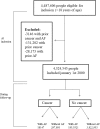Incidence of atrial fibrillation in different major cancer subtypes: a Nationwide population-based 12 year follow up study
- PMID: 31726997
- PMCID: PMC6854796
- DOI: 10.1186/s12885-019-6314-9
Incidence of atrial fibrillation in different major cancer subtypes: a Nationwide population-based 12 year follow up study
Abstract
Background: The prevalence of both atrial fibrillation (AF) and malignancies are increasing in the elderly, but incidences of new onset AF in different cancer subtypes are not well described.The objectives of this study were therefore to determine the incidence of AF in different cancer subtypes and to examine the association of cancer and future AF.
Methods: Using national databases, the Danish general population was followed from 2000 until 2012. Every individual aged > 18 years and with no history of cancer or AF prior to study start was included. Incidence rates of new onset AF were identified and incidence rate ratios (IRRs) of AF in cancer patients were calculated in an adjusted Poisson regression model.
Results: A total of 4,324,545 individuals were included in the study. Cancer was diagnosed in 316,040 patients. The median age of the cancer population was 67.0 year and 51.5% were females. Incidences of AF were increased in all subtypes of cancer. For overall cancer, the incidence was 17.4 per 1000 person years (PY) vs 3.7 per 1000 PY in the general population and the difference increased with age. The covariate adjusted IRR for AF in overall cancer was 1.46 (95% confidence interval (CI) 1.44-1.48). The strength of the association declined with time from cancer diagnosis (IRR0-90days = 3.41 (3.29-3.54), (IRR-180 days-1 year = 1.57 (CI 1.50-1.64) and (IRR2-5 years = 1.12 (CI 1.09-1.15).
Conclusions: In this nationwide cohort study we observed that all major cancer subtypes were associated with an increased incidence of AF. Further, cancer and AF might be independently associated.
Keywords: Arrhythmia; Atrial fibrillation; Cancer; Malignancy.
Conflict of interest statement
All authors have completed the ICMJE uniform disclosure form at
ML has received speaker fees from Bristol-Meyer Squibb and Bayer.
NC has received grants from The Danish Heart Foundation, The Danish Kidney Foundation, The Department of Cardiology at Gentofte Hospital, and the Department of Nephrology at Herlev Hospital, Helen and Ejnar Bjoernows Foundation, The Danish Society of Nephrology and the Health Foundation.
CTP reports grants, personal fees and other from Bayer, grants from Biotronic and Bristol Meyer and grants from Novo.
GG is supported by an unrestricted clinical research scholarship from the Novo Nordisk Foundation.
CJ, MLH and MS have no competing interest.
Figures







References
-
- Camm AJ, Lip GY, De Caterina R, et al. 2012 focused update of the ESC guidelines for the management of atrial fibrillation: an update of the 2010 ESC guidelines for the management of atrial fibrillation--developed with the special contribution of the European heart rhythm association. Europace. 2012;14(10):1385–1413. doi: 10.1093/europace/eus305. - DOI - PubMed
MeSH terms
LinkOut - more resources
Full Text Sources
Medical

